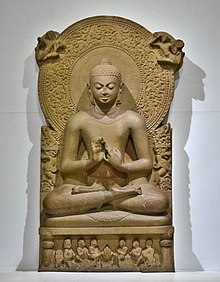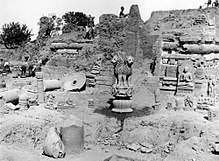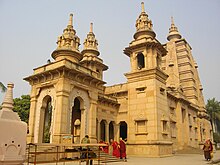Dharmachakra Pravartana Buddha at Sarnath

Dharmachakra Pravartana Buddha at Sarnath is the famous Gupta period (5th cent CE) sculpture of the Buddha Shakyamuni in the Dharmachakra Pravartana mudra discovered during the excavations at Sarnath, near Varanasi in Uttar Pradesh, India. It is regarded to be a masterpiece of Gupta art and craftsmanship and has been widely reproduced. After the Lion Capital of Ashoka, which now serves as the symbol of the nation of India, this is the best known sculpture at Sarnath. This 5 feet 3 inch sandstone sculpture is now preserved at the Sarnath Museum, catalogue no. [B(b)181][1]
Dharmachakra Pravartana image at Sarnath[]
The sculpture is symbolic of the Saranath itself, where the Buddha initiated his teachings, which are recorded on the Pali Dhammacakkappavattana Sutta. In this sculpture, the Buddha is seated in vajra-paryankasana (also termed padmāsana) and is delivering the first sermon to the five disciples shown on the pedestal with the Dharmachakra in its centre. It is flanked by a pair of gazelles, symbolizing the deer park (Mrigadava) at Sarnath. The five disciples were Kaundinya, Assaji, Bhaddiya, Vappa and Mahanama, all of them Brahmins who had known Siddharth in the past. They are known as the Pañcavaggiyā monks. In addition to the five, there is a kneeling woman and a child. The throne has a makara and a vyala (shardula) on both sides, as required by convention. On both sides of the circular ornate prabhamandala, there are two flying gandharvas bearing chamara or flowers.
The hands of the Buddha are in the dharmachakra pravartana mudra, as of the Buddha is rotating the wheel of Dharma. The Dharma Chakra represents the dharma as preached by the Shakyamuni Buddha. According to some scholars, the dharmachakra pravartana mudra was first used by the sculptors at Sarnath.
Sarnatha is intimately connected by the Dharma-chakra. The Lion Capital of Ashoka originally supported a large Dharma-chakra (thus the lions served as the support for the Dharma Chakra). During the excavations, the stone Dharma Chakra was found broken. The Dharma Chakra Jina Vihar at Sarnath was built by Kumaradevi born in the Pala family, a wife of Gahadavala Govindachandra (c. 1114–1155 CE), which was the last structured constructed before the devastation of Sarnath.
The sculpture as a Gupta Masterpiece[]

Of the hundreds of Buddha images produced by the Sarnath School, most significant being the Dharmachakrapravartana image of Lord Buddha which is symbolic of the First Sermon preached by the Master at the Deer Parks in Sarnath.
Krishna Dev described the sculpture as follows.[2] "This outstanding image radiates the Master's adamant resolve and strength, combined with complete equanimity, compassion and tender grace. The inspired artist of this masterpiece has caught the moment when the great teacher who had achieved Supreme Enlightenment after six years of strenuous exertion, felt overwhelmed with compassion for the suffering humanity and condescended to turn the Wheel of Law... The momentous events of the First Sermon and the founding of the Buddhist Sangha are immortalised in this unique sculpture .. Combining elemental strength with tender grace and subtle delicacy with transcendental sublimation, this luminous image indeed constitutes a masterpiece of the Indian, nay World art, enshrining the noble teachings of Lord Buddha."
Radha Kumud Mookerji, archaeologist and a member of the parliament, writes [3] "The Sarnath seated image of the Buddha in the act of his preaching the first sermon is considered as one of the masterpieces of Indian Art, and of its Gupta style marked by its symbolism. .. His hands are shown in the position known as Dharma- Chakra-pravartana-mudra. Indeed, there was a great development in the mudras in the Buddhist Iconography of the time."
John Huntington[4] analyzed this sculpture in detail. He writes "The image is also highly nuanced and to the aware observer has a vastly complex Buddhological message, to be read on several levels."
Catherine Becker writes [5] "This Gupta period depiction of the Buddha turning the wheel of dharma in the deer park at Sarnath is arguably one of the most famous Buddha images from ancient South Asia - a canonical example of the "golden age" of Gupta sculpture."
The Dharmachakra Pravarana Buddha image at the Mulagandhakuti Vihara[]


After the excavations, a new temple was commissioned by the Maha Bodhi Society for construction in 1931. The frescoes on the walls were painted by the noted Japanese painter, Kosetsu Nosu.[6] The focal point of the temple is a gilded replica of the famous sculpture of the Buddha in the Dharmachakra Pravartana mudra. Anagarika Dharmapala, the founder of the Maha Bodhi Society actively guided the construction of the temple.
Replicas of the Saranath Buddha[]
The image is sometimes referred to as simply as the Saranath Buddha. This is one of the most reproduced Buddha images. Major reproductions include the following.
- Birla Mandir Delhi Buddha Vihar, inaugurated by Mahatma Gandhi in 1939.
- On one face of the Rajgir Vishwa Shanti Stupa
- India gifted a 16-feet high Buddha statue to Sri Lanka to be installed at the sacred Sri Dalada Maligawa temple at Kandy in 2010.[7]
- Replica at the Luoyang White Horse Temple within the Sanchi stupa replica (Yindufodian)[8]
- Replica at the Palelai temple Singapore.
- Poh Ern Shih Temple, Singapore
- Ancient sandstone replica found at an Udupi suburb [9] in 2021.
Small as well as large replicas in wood, marble, bronze, terracotta and plaster are widely reproduced and sold in India and overseas using the term "Sarnath Buddha".
See also[]
- Sarnath
- Dharmachakra
- Dhammacakkappavattana Sutta
- Bala Bodhisattva
Photo gallery[]
Budhha Vihar in Birla Mandir Complex Delhi

Rajgir Vishwa Shanti Stupa

Poh Ern Shih (Singapore) Sarnath Buddha

White Horse Temple Indian hall (Yindufodian), Luoyang, China

A different Dharmachakra Pravartana Buddha in from Sarnath from the same period, British Museum.

Phra Buddha Mettapanyanath (10 feet high), Wat Khung Taphao, Thailand

International Buddhist Museum at Kandy, Sri Lanka

Buddha Shakyamuni or Vairochana Kashmir

Monastery of Tam Bao Son, Quebec, Canada. Isipatanagaya, Buddha giving his first sermon to his five disciples
References[]
- ^ Catalogue of the Museum of Archaeology at Sarnath, Daya Ram Sahni, 1914
- ^ Dharmachakra Pravartana Image of Buddha at Sarnath, Krishna Deva, The Maha Bodhi Centenary Volume. 1891 - 1991 p. 131-132
- ^ Radha Kumud Mookerji, The Gupta Empire, Motilal Banarasidas, 1973, p. 142
- ^ John Huntington. Understanding the 5th Century Buddhas of Sarnath: A Newly Identified Mudra and a New Comprehension of the Dharmachakra Mudra, Orientations, March 2009, p 84-93
- ^ Catherine Becker, Shifting Stones, Shaping the Past: Sculpture from the Buddhist Stupas of Andhra Pradesh, Oxford University Press, 2014, p. 156
- ^ Kosetsu Nosu: The Japanese Artist who Painted at Sarnath, Satyasri Ukil, 2010
- ^ India to gift Buddha statue to Lanka, Sutirtho Patranobis, Hindustan Times, Colombo, December 21, 2010]
- ^ Buddha in China, from 'Indu' - Sanchi stupa replica promised by Atal nears completion, ASHIS CHAKRABARTI, The Telegraph 31.12.08
- ^ Miniature Sculpture Of Saranath Buddha Unearthed, May 25, 2021
| Edicts of Ashoka (Ruled 269–232 BCE) | |||||
| Regnal years of Ashoka |
Type of Edict (and location of the inscriptions) |
Geographical location | |||
| Year 8 | End of the Kalinga war and conversion to the "Dharma" |  Udegolam Nittur Brahmagiri Jatinga Rajula Mandagiri Sasaram Bairat Bhabru Ahraura Barabar Kandahar (Greek and Aramaic) Kandahar Girnar Khalsi Sopara Jaugada Shahbazgarhi Sannati Sarnath Sanchi Lumbini Nigali Sagar Nigali Sagar Nandangarh Kosambi Topra Meerut Araraj,Rampurva Rampurva Ai Khanoum (Greek city) Pataliputra Ujjain | |||
| Year 10[1] | Minor Rock Edicts | Related events: Visit to the Bodhi tree in Bodh Gaya Construction of the Mahabodhi Temple and Diamond throne in Bodh Gaya Predication throughout India. Dissenssions in the Sangha Third Buddhist Council In Indian language: Sohgaura inscription Erection of the Pillars of Ashoka | |||
| Kandahar Bilingual Rock Inscription (in Greek and Aramaic, Kandahar) | |||||
| Minor Rock Edicts in Aramaic: Laghman Inscription, Taxila inscription | |||||
| Year 11 and later | Minor Rock Edicts (n°1, n°2 and n°3) (Panguraria, Maski, Palkigundu and Gavimath, Bahapur/Srinivaspuri, Bairat, Ahraura, Gujarra, Sasaram, Rajula Mandagiri, Yerragudi, Udegolam, Nittur, Brahmagiri, Siddapur, Jatinga-Rameshwara) | ||||
| Year 12 and later[1] | Barabar Caves inscriptions | Major Rock Edicts | |||
| Minor Pillar Edicts | Major Rock Edicts in Greek: Edicts n°12-13 (Kandahar) Major Rock Edicts in Indian language: Edicts No.1 ~ No.14 (in Kharoshthi script: Shahbazgarhi, Mansehra Edicts (in Brahmi script: Kalsi, Girnar, Sopara, Sannati, Yerragudi, Delhi Edicts) Major Rock Edicts 1-10, 14, Separate Edicts 1&2: (Dhauli, Jaugada) | ||||
| Schism Edict, Queen's Edict (Sarnath Sanchi Allahabad) Lumbini inscription, Nigali Sagar inscription | |||||
| Year 26, 27 and later[1] |
Major Pillar Edicts | ||||
| In Indian language: Major Pillar Edicts No.1 ~ No.7 (Allahabad pillar Delhi pillar Topra Kalan Rampurva Lauria Nandangarh Lauriya-Araraj Amaravati) Derived inscriptions in Aramaic, on rock: | |||||
- Sarnath
- Buddha statues in India
- 5th-century sculptures
- Gupta art










